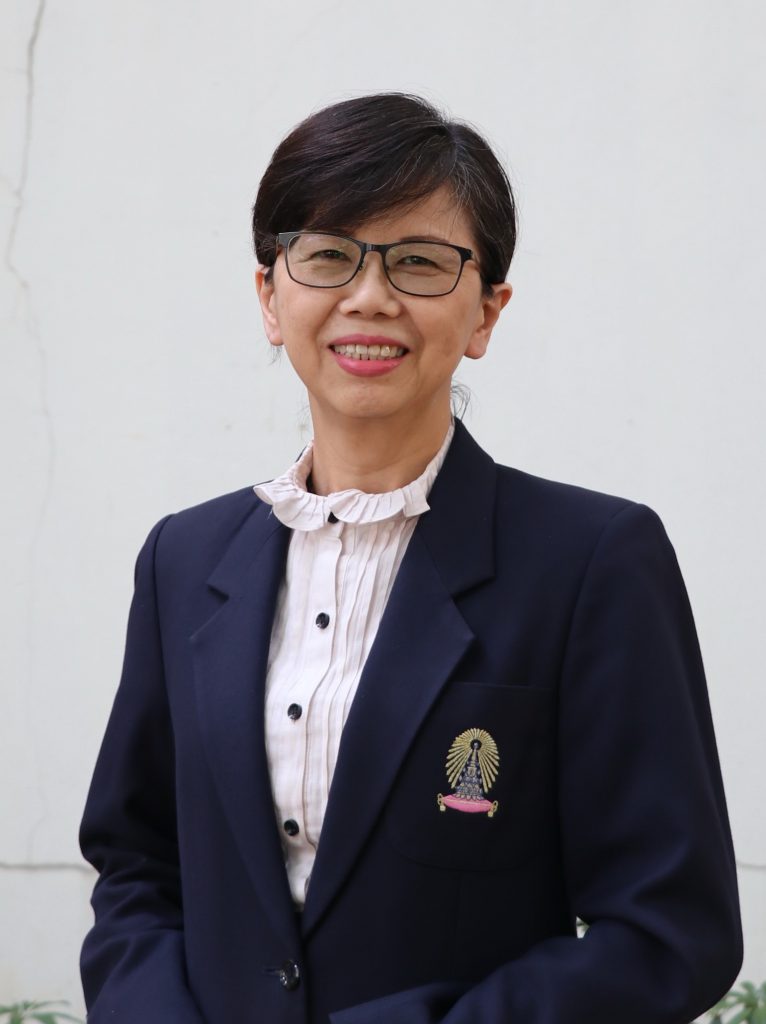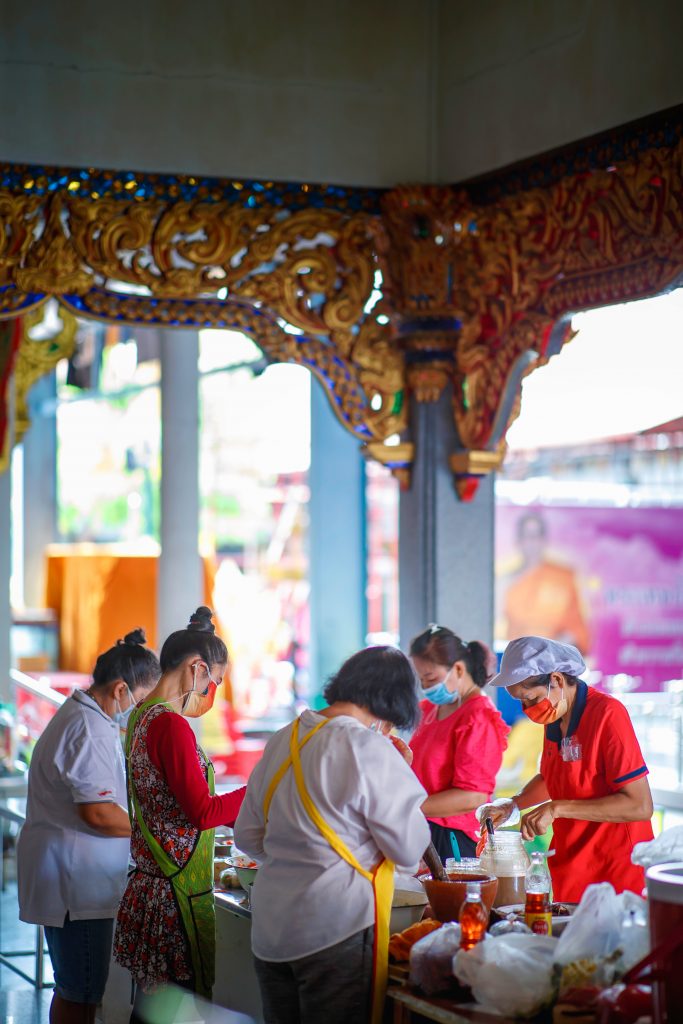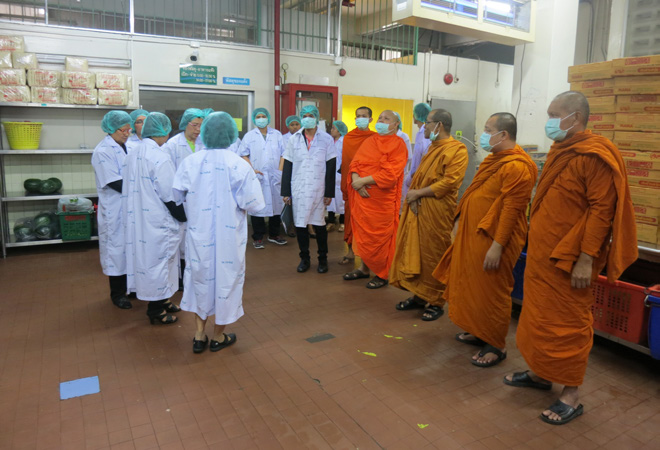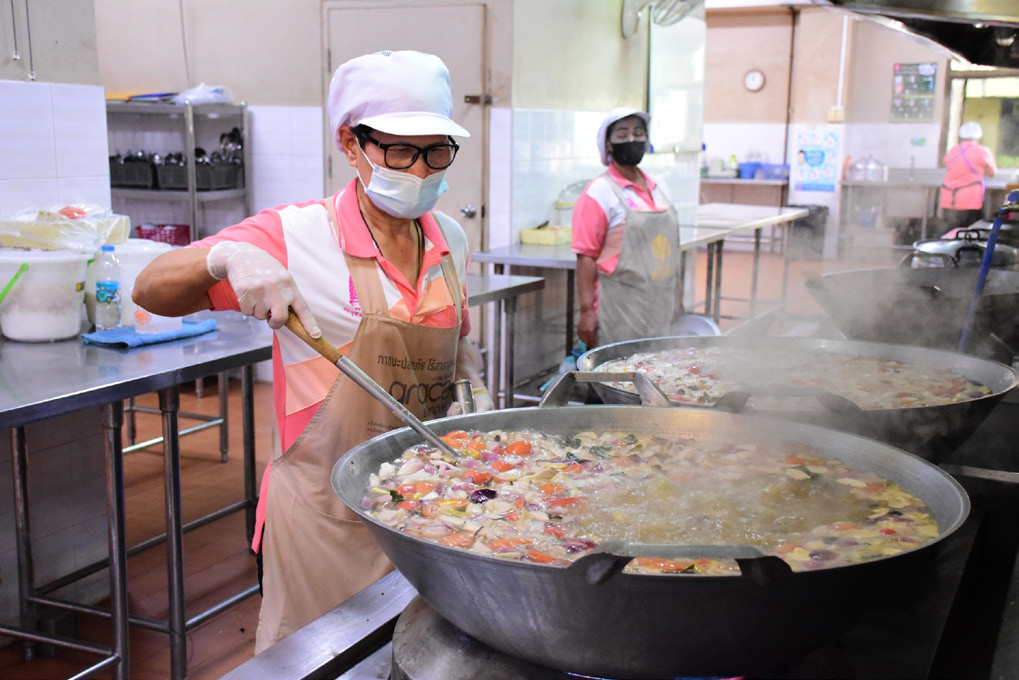The Faculty of Allied Health Sciences, Chulalongkorn University, in collaboration with Maha Chulalongkorn Rajavidyalaya University propose the way to create a “model kitchen” and a variety of media to educate the public about nutrition and food safety of the offerings to monks and advise the public to make merit by building a hygienic kitchen for monks for their good health.
Giving alms and making food offerings to monks are popular merit-making activities among Thai people, especially during religious festivals and celebrations. People bring home-cooked food or cook at the temple’s kitchen to make offerings to the monks and also feed temple residents and villagers for charity. Sometimes, however, such good intentions can also do harm.
“A study done on food from the temple’s kitchen and food offerings, in general, found a high risk of microbial contamination. Food storage and handling by the staff of the temple’s kitchen was found to be unsafe and could make the monks sick of food poisoning,” Asst. Prof. Dr. Tipayanate Ariyapitipun, Head of the Department of Nutrition and Dietetics, Faculty of Allied Health Sciences, Chulalongkorn University revealed the results of a study on the nature of food safety hazards in monks’ food.

Asst. Prof. Dr. Tipayanate Ariyapitipun
“Sanitation in many temple kitchens has not met safety standards, and most monks, chefs, and congregations who help in the kitchen lack awareness of nutrition and food safety that will affect the health of monks in the long run. There is a chance of cross-contamination between raw and cooked foods. Food preparation and cooking still share the same area, without clear zoning, improper preparation and storage of raw materials, placement of raw materials, utensils, and containers that contact with food right on the floor, or at the level lower than standards, as well as keeping the cooked food covered before serving also has a risk of contamination from the environment,” said Asst. Prof. Dr. Tipayanate while detailing risky behaviors that may affect the monks’ health in the short and long run.

Develop “people” to create a “model temple kitchen”
From the results of food safety studies, Asst. Prof. Dr. Tipayanate, together with Prof. Dr. Jongjit Angkatavanich, Head of the Sonk Thai Glai Rok (Thai Monks Away from Illness) Project, in collaboration with the Office of Buddhism Promotion and Social Service (BPS), Maha Chulalongkorn Rajavidyalaya University (MCU), initiated the Monk’s Model Kitchen for Good Nutrition Project in 2016, and have been developing the model kitchen as a space for research.
“The important factor in creating a model kitchen is the people,” Asst. Prof. Dr. Tipayanate emphasized. “In order to create a model kitchen we must start from creating an understanding and awareness among the monks and concerned staff about the advantages and benefits of the model kitchen. Then we can provide the training to educate them about nutrition and food safety to reduce the risk of cross-contamination, the correct way of hand-washing, an inspection of hand cleanliness with the SI-2 test kit, and how to initially detect materials contamination with a rapid test kit to determine substances like borax, formalin, bleach, and so on.”
After the training, the project administered a test to the trainees and received satisfactory results. “The chefs in the MCU kitchen showed a better understanding and a keen awareness of food safety,” Asst. Prof. Dr. Tipayanate said.
In addition, the project also took those involved in the temple kitchen on a study tour of the kitchens that meet international standards, such as Thai Airways International kitchen, the Nutrition Department of Monk Hospital, Ramathibodi Hospital, Phramongkutklao Hospital, and Rajavithi Hospital.

“We want people involved to gain a firsthand experience of many types of standardized kitchens to spark some ideas that can be built on in setting up standardized kitchens for monks. We want them to see how to operate according to food safety practices, to observe the guidelines for organizing a healthy menu of monks, as well as to raise their awareness on the importance of proper dress code in the kitchen, namely wearing hair a cover, a face mask, clean gloves, and clean clothing that are separate from what they wear at home, etc.”

Must-have items in the model kitchen
Asst. Prof. Dr. Tipayanate has participated in developing the MCU kitchen into a model kitchen and received a quality assessment according to the Ministry of Public Health’s standards in March. Model kitchens should have the following key characteristics:
- There should be plenty of space to operate because if the kitchen is too small, it’s easy for contamination to occur. It is difficult for people to work and there may be accidents during the operation.
- A good kitchen must be a closed kitchen, and not always open for anyone to enter and exit at any time. The kitchen area should be reserved only for kitchen staff to prepare and cook food.
- The kitchen should have separate entrances and paths for raw materials and cooked food, starting from the dirty area toward cleaner space, and no turning back. Working areas should be separated to prevent cross-contamination.
- Chefs and kitchen staff who work full-time at the temples should receive food safety training and be registered as food handlers.
- Temporary help and people who come to use the kitchen from time to time should also be trained on basic food safety and wear the attire provided by the temple, such as a kitchen uniform (if any), apron, mask, hair cover, gloves, etc.
- Raw materials and kitchen equipment should be stored systematically, organized, and separated to prevent cross-contamination from raw food to cooked food, and from animals carrying diseases. Examples of best food safety practices are washbasins, sinks, and storage areas for raw materials and dishes should be separate and located in far apart areas; cutting boards and knives for cooked food and raw materials should also be separate; food and containers should be placed at least 60 cm above ground, according to food safety standards; prevention of disease-carrier animals from coming into contact with cooked food, utensils, raw materials, and so on should be in place.
- The kitchen should be certified for food safety by the Ministry of Public Health and have a food safety evaluation team within the temple to monitor the kitchen and the staff.
Monk’s kitchen is confident to fend off COVID-19
Since the model kitchen focuses on safety and cleanliness, Asst. Prof. Dr. Tipayanate added more tips to tackle the COVID-19 pandemic.
“The project has produced video clips and infographics on “monk’s kitchen is confident to fend of COVID-19″ topic, such as how to prepare sodium hypochlorite solution to kill COVID-19 virus, how to clean eggs before storing or cooking, how to store raw materials and ready-to-use containers, as well as methods on how to dispose of garbage to be safe from Covid-19. The project also produces information for monks on what to do while eating food, how to wash the monks’ bowls and utensils, and how to wash their hands following the 9 steps to be safe from COVID-19.”
Collaborating to create a hygienic “model kitchen”
Asst. Prof. Dr. Tipayanate proposed the idea that apart from offering food for merit, donating to support the construction, and procurement of standardized kitchen equipment of the model kitchen that meets international food safety standards is also a great way of merit-making. Such an act promotes the monks’ safety and reduces their health risk of food poisoning so that they can propagate Buddhism to their full potential.
“If a temple does not have a supervisor or a management system, only the kitchen, at least provide a sink at the entrance to the kitchen, hair cover, and hygienic masks to wear before entering the kitchen to prepare food for monks. And with the current situation, where everybody has to wear a mask already, it’s a good opportunity to adjust the congregation’s behavior that’s relevant to the kitchen. Simply start with these three things – wash your hands, wear a hair cover, and wear a mask – and you can help provide basic food safety for monks. We can make REAL merit this way.”
More information on “Model Kitchen” and all the media can be downloaded at www.sonkthaiglairok.com.
